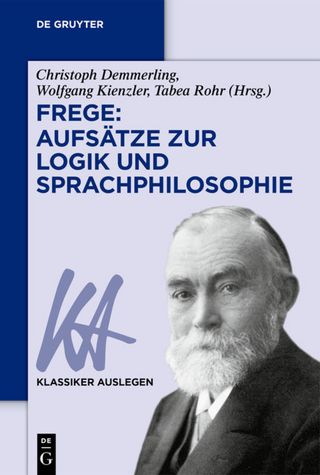
Informal Fallacies
Benjamins (John) North America Inc.,US (Verlag)
978-1-55619-010-0 (ISBN)
1. Chapter 1: A New Model of Argument; 2. 1. Introduction to the Fallacies; 3. 2. Some More Fallacies; 4. 3. Fallacies Combined in Realistic Dialogues; 5. 4. What is an Argument?; 6. 5. Criticism as Challenge and Response; 7. 6. Basic Categories of Argument Study; 8. Notes: Chapter 1; 9. Chapter 2: Hot Rhetoric and Argument; 10. 1. Appeals to Popular Sentiment; 11. 2. Appeals to Force; 12. 3. Appeals to Pity; 13. 4. Overly Personal Argumentation; 14. 5. The Rhetorical Debate; 15. 6. Case Study: Parliamentary Debate; 16. 7. Conclusion; 17. Notes: Chapter 2; 18. Chapter 3: The Logic of Propositions; 19. 1. Deductive Validity; 20. 2. Formal Logic; 21. 3. Classical Propositional Calculus; 22. 4. Applying Deductive Logic to Arguments; 23. 5. Invalidity and Fallaciousness; 24. 6. Relevance and Validity; 25. 7. Subject-Matter Relatedness; 26. 8. Relatedness Logic; 27. 9. Semantics and Pragmatics; 28. 10. What is a Fallacy?; 29. Notes: Chapter 3; 30. Chapter 4: Logical Dialogue-Games; 31. 1. Different Approaches to Formal Dialogues; 32. 2. The Ad Ignorantiam Fallacy; 33. 3. Fallacies of Question-Asking; 34. 4. The Fallacy of Many Questions; 35. 5. Demanding Direct Answers to Questions; 36. 6. Misconception of Refutation; 37. 7. Case Studies of Political Debates; 38. 8. A Game with Dark-Side Commitments; 39. Notes: Chapter 4; 40. Chapter 5: Enthymemes; 41. 1. The Tradition of Enthymemes; 42. 2. The Objectives of Dialogue; 43. 3. Veiled Commitment-Sets; 44. 4. Strategy and Plausibility; 45. 5. The Problem Resolved; 46. 6. Order of the Premisses; 47. 7. Multiple Premisses in Complex Arguments; 48. Notes: Chapter 5; 49. Chapter 6: Longer Sequences of Argumentation; 50. 1. Sequences of Argumentation; 51. 2. Graphs of Arguments; 52. 3. Case Study: Argument on Sex Education; 53. 4. Case Study: Circular Argumentation; 54. 5. Plausibility Conditions on Arguments; 55. 6. The Missing Links; 56. 7. Conclusions on Circular Arguments; 57. Notes: Chapter 6; 58. Chapter 7: Fallacious Arguments From Authority; 59. 1. How Appeals to Authority Can Go Wrong; 60. 2. Plausible Argument; 61. 3. Where Experts Disagree; 62. 4. Expertise and Legal Dialogue; 63. 5. Dialogue and Expertise; 64. 6. Conclusions; 65. Notes: Chapter 7; 66. Chapter 8: Various Fallacies; 67. 1. Inductive Fallacies; 68. 2. Deductive and Inductive Arguments; 69. 3. Post Hoc Arguments; 70. 4. Slippery Slope; 71. 5. Equivocation; 72. 6. Amphiboly; 73. 7. Composition and Division; 74. Chapter 9: Arguments Against the Person; 75. 1. Poisoning the Well; 76. 2. The Sportsman's Rejoinder; 77. 3. Evaluating Ad Hominem Disputations; 78. 4. Four Types of Circumstantial Ad Hominem; 79. 5. Rhetorical Context of Ad Hominem Attacks; 80. 6. Positional Defensibility; 81. 7. Conclusion; 82. Notes: Chapter 9; 83. Chapter 10: Equivocation; 84. 1. What is Equivocation?; 85. 2. Vagueness and Criticisms of Equivocality; 86. 3. The Problem of Subtle Equivocations; 87. 4. Deep Deception and Equivocal Dialogue; 88. 5. Many-Valued Logic for Equivocators; 89. 6. Priests's System LP; 90. 7. Applying LP to the Fallacy of Equivocation; 91. 8. R-Mingle as a Logic for Equivocators; 92. 9. RM and Equivocation; 93. 10. Conclusions; 94. Notes: Chapter 10; 95. Chapter 11: Informal Logic as a Discipline; 96. 1. The Role of Formal Logic; 97. 2. Dialectic as a Theory of Argument; 98. 3. Function of Why-Questions; 99. 4. Subject-Specific Nature of Arguments; 100. 5. Case Studies on Circular Reasoning; 101. 6. Conversational Pragmatics; 102. 7. Pedagogical Directions for Informal Logic; 103. Notes: Chapter 11; 104. Bibliography; 105. Index
| Erscheint lt. Verlag | 1.1.1987 |
|---|---|
| Reihe/Serie | Pragmatics & Beyond Companion Series ; 4 |
| Sprache | englisch |
| Maße | 164 x 245 mm |
| Gewicht | 775 g |
| Themenwelt | Geisteswissenschaften ► Philosophie ► Logik |
| Geisteswissenschaften ► Sprach- / Literaturwissenschaft ► Sprachwissenschaft | |
| ISBN-10 | 1-55619-010-7 / 1556190107 |
| ISBN-13 | 978-1-55619-010-0 / 9781556190100 |
| Zustand | Neuware |
| Informationen gemäß Produktsicherheitsverordnung (GPSR) | |
| Haben Sie eine Frage zum Produkt? |
aus dem Bereich


